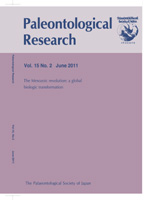The Lamniformes are a shark clade which occupies the highest trophic-level regimes in extant marine ecosystems, and includes the largest fish-eating shark, Carcharodon carcharias. However, the ancestor of this taxon is thought to be a small shark. In order to evaluate the trophic position of the lamniform shark ancestor, I first developed a new method to estimate the mouth size of fossil lamniform sharks from isolated teeth, and then estimated the mouth size of the oldest recorded lamniform shark genus, Protolamna. This method can predict the mouth size of a fossil lamniform shark if the original tooth position within a jaw or the most closely related extant species is unknown. The result suggests that the mouth size of Protolamna was smaller than most extant Lamniformes. This estimate indicates that they likely fed on small prey, considering that mouth size determines the upper limit of prey size. This finding indicates that extant lamniform sharks evolved from lower trophic-level ancestors.
How to translate text using browser tools
1 June 2011
Mouth-Size Estimation of a Primitive Lamniform Shark, Protolamna: Low Trophic Position in Lamniform Shark Origin
Taketeru Tomita
ACCESS THE FULL ARTICLE

Paleontological Research
Vol. 15 • No. 2
June 2011
Vol. 15 • No. 2
June 2011
lamniform shark
Protolamna
regression analysis
trophic level




